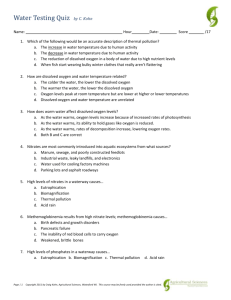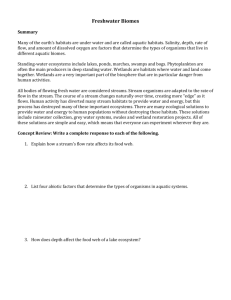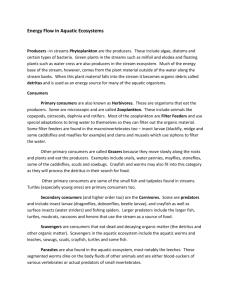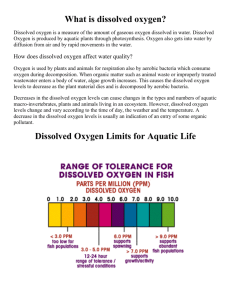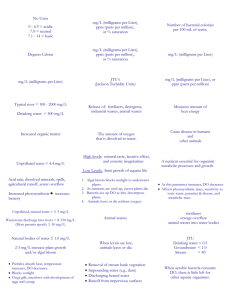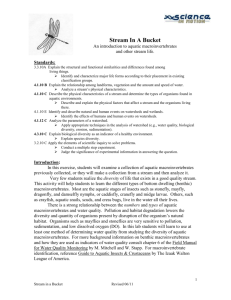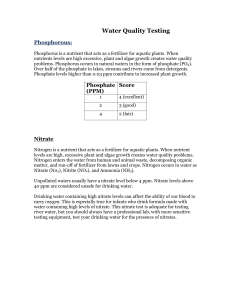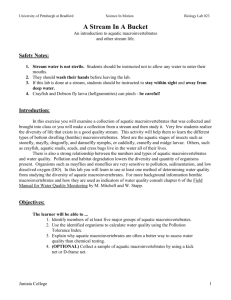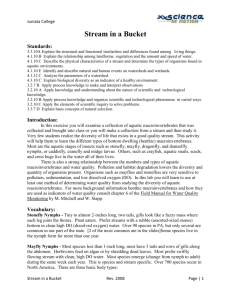Questions and Activities for Nepal Collaboration with LFUCG water
advertisement
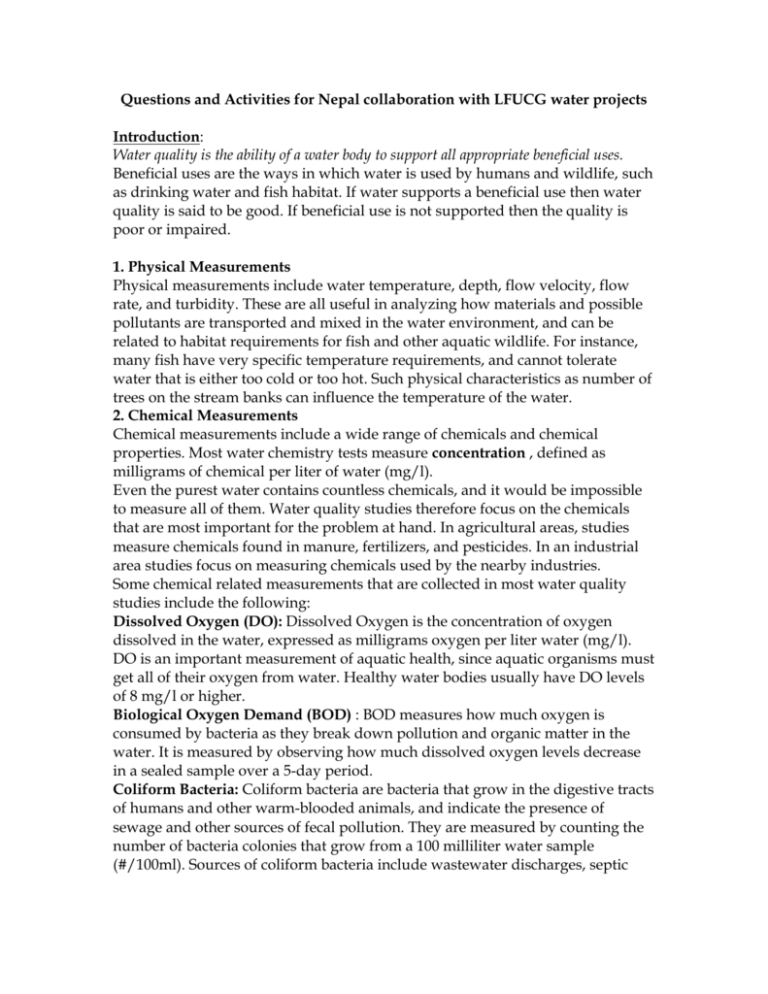
Questions and Activities for Nepal collaboration with LFUCG water projects Introduction: Water quality is the ability of a water body to support all appropriate beneficial uses. Beneficial uses are the ways in which water is used by humans and wildlife, such as drinking water and fish habitat. If water supports a beneficial use then water quality is said to be good. If beneficial use is not supported then the quality is poor or impaired. 1. Physical Measurements Physical measurements include water temperature, depth, flow velocity, flow rate, and turbidity. These are all useful in analyzing how materials and possible pollutants are transported and mixed in the water environment, and can be related to habitat requirements for fish and other aquatic wildlife. For instance, many fish have very specific temperature requirements, and cannot tolerate water that is either too cold or too hot. Such physical characteristics as number of trees on the stream banks can influence the temperature of the water. 2. Chemical Measurements Chemical measurements include a wide range of chemicals and chemical properties. Most water chemistry tests measure concentration , defined as milligrams of chemical per liter of water (mg/l). Even the purest water contains countless chemicals, and it would be impossible to measure all of them. Water quality studies therefore focus on the chemicals that are most important for the problem at hand. In agricultural areas, studies measure chemicals found in manure, fertilizers, and pesticides. In an industrial area studies focus on measuring chemicals used by the nearby industries. Some chemical related measurements that are collected in most water quality studies include the following: Dissolved Oxygen (DO): Dissolved Oxygen is the concentration of oxygen dissolved in the water, expressed as milligrams oxygen per liter water (mg/l). DO is an important measurement of aquatic health, since aquatic organisms must get all of their oxygen from water. Healthy water bodies usually have DO levels of 8 mg/l or higher. Biological Oxygen Demand (BOD) : BOD measures how much oxygen is consumed by bacteria as they break down pollution and organic matter in the water. It is measured by observing how much dissolved oxygen levels decrease in a sealed sample over a 5-day period. Coliform Bacteria: Coliform bacteria are bacteria that grow in the digestive tracts of humans and other warm-blooded animals, and indicate the presence of sewage and other sources of fecal pollution. They are measured by counting the number of bacteria colonies that grow from a 100 milliliter water sample (#/100ml). Sources of coliform bacteria include wastewater discharges, septic tanks, domestic animals, and wildlife. Fecal coliform counts greater than about 200 #/100ml are thought to be unsafe for swimming. Nitrate (NO3) and Phosphate (PO4): Nitrates and phosphates are nutrients that come from both natural sources and human activities (fertilizers, detergents, wastewater). These nutrients determine the productivity of a water body, and are needed at some level to provide good aquatic habitat. However, pollution from manure, fertilizer, and wastewater can cause excessive nutrient levels. Too much nitrate or phosphate causes algae to grow out of control, reducing light and oxygen for fish. pH : pH is a measure of the acidity of water, and is important in understanding the chemical balance of the water. pHs below 7 indicate acid conditions, while pHs above 7 indicate alkaline conditions. pH is a strong determinant of the solubility and availability of both nutrients and pollutants. Most natural water bodies will have pHs close to 7, depending on the local geochemistry. Very low pHs (less than about 6) can come from acid rain, industrial sources, or mine drainage. 3. Biologic Indicators Our understanding of the needs of aquatic wildlife is incomplete, and water chemistry testing does not tell us everything about the suitability of a water body as habitat. An alternative approach is to measure the abundance, diversity, and health of different kinds of aquatic plants and animals. This data is then analyzed to come up with an indicator of water quality. The simplest biologic approach is toxicity testing . This involves placing a group of small animals in a water sample and observing how many die or become sick. This is most often done with water fleas and small fish. Toxicity testing provides useful but difficult-to-interpret data. Conditions in a laboratory sample are quite different from field conditions, and at the end of the test you only know that the animal died - you don't know what killed it. Still, toxicity testing is a useful check on chemical test results, especially if there is a toxic pollutant in the water that you did not include in your water chemistry analysis. Another biologic approach is to measure the numbers and types of macroinvertebrates found in a stream. Macroinvertebrates are aquatic insects, insect larvae, crustaceans, and other smaller animals that spend their lives in water. We know that different species can tolerate different levels of pollution, and can use this knowledge to measure water quality. For instance, a stream that has lots of stone fly and mayfly larvae would have very high water quality, while a stream that has only water striders and aquatic snails might have poor water quality. Like toxicity testing, this method doesn't tell you why animals are present or absent, but it can help you identify what problems to investigate. In the process of studying the water quality in our urban ecosystem, we will be collecting some physical data such as the vegetation present in area of the stream, land cover, slope of surroundings, presence of manmade surfaces and buildings, etc. We can collect chemical data on dissolved oxygen and pH. We can collect biologic data about the macroinvertebrates that are found in the stream. From this data we can draw some conclusions about the quality of the water as defined above. Guiding Questions: How do stream ecosystems respond physically, biologically and chemically to urbanization? How do we measure the quality of the water in nature? How is water quality affected by urban environments? How are the stream ecosystems in Kathmandu and Lexington alike and different? How do we use water quality information to promote sustainability of urban environments and urban stream ecosystems? Activities Make a map for a certain radius around your home showing different kinds of urban environments; residential, shopping, parks, office buildings, industrial areas. Construct food web diagrams for some ecosystems in your area. Explore the question of whether your city or community has too many people. Can your local ecosystem support the population for the foreseeable future? What are the advantages of having more or less people? Interview grandparents or others that have lived in your area for a long time. How have natural, agricultural and urban ecosystems changed? Compare a map of your community from 50 years ago with a current map. Two different approaches to the international collaboration could involve: Students work through activities as a whole class and share information with the distant partner school. Information sharing could take place through exchange of flash drives shipped via FedEx packages, or through email or other internet dependent channels. Students may work on individual projects with a partner at the distant school. Students collaborate on an experiment that becomes an entry in the local or regional science fair. Collaborators may even travel to the distant site to present projects with their partners at the respective fairs.
